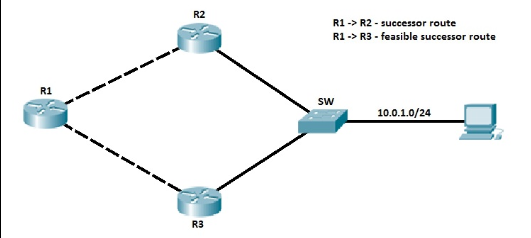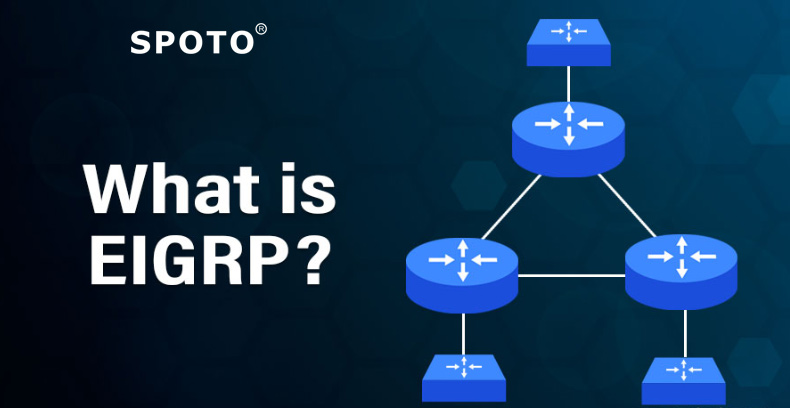EIGRP (Enhanced Interior Gateway Routing Protocol) is a high-level distance vector routing protocol. The agreement is the evolution of the early Cisco agreement, known as the Internet, and is now being phased out. EIGRP supports classless routing and VLSM, routing aggregation, incremental updates, load balancing, and many other useful features. It is a Cisco proprietary protocol, so all routers in the network running EIGRP must be a Cisco router.
Before you exchange routing information, the router running EIGRP must be a neighbor. To dynamically discover neighbors, the EIGRP router uses a multicast address of 224.0. 0.10. Each EIGRP router stores routing and topology information in three tables:
Neighbor table – stores information about EIGRP neighbors
Topology table – stores routing information learned from neighboring routers
Routing table – stores the best routes
The management distance of EIGRP is 90, which is less than the management distance of RIP and OSPF, so EIGRP routing will take precedence over these routes. EIGRP uses the reliable transport protocol (RTP) to send messages.
EIGRP calculates its metrics by using bandwidth, latency, reliability, and load. By default, only the bandwidth and delay are used in the calculation of the metrics, and the reliability and load are set to zero.
EIGPR uses the concept of autonomous systems. Autonomous systems are a set of routers that should be EIGRP enabled, and they should become EIGRP neighbors. Each router in an autonomous system must be equipped with the same autonomous system number, otherwise the router will not become a neighbor.
EIGRP Neighbors
Before exchanging routing information, EIGRP must establish neighbor relationships with other EIGRP neighbor routers. In order to establish a neighbor relationship, the router sends hello packets every two seconds. The Hello packet will be sent to the multicast address of 224.0.0.10.
NOTE
On the LAN interface, send hello every 5 seconds.
On the WAN interface, every 60 seconds. The following fields in the hello packet must be the same so that the router becomes a neighbor:
· ASN (autonomous system number)
· subnet number
· K values (components of metric)
The router sends hello packets every few seconds to ensure that the neighbor relationship is still active. By default, routers treat neighbors as Down. after suppressing timer timeout By default, keep the timer three times the hello interval. On the LAN network, the suppression timer is 15 seconds.
Feasible and reported distance
The two terms that are often encountered while using EIGRP are feasible and report the distance. Let’s clarify these terms:
Feasible distance (FD) – An indicator of the best route to the network. The route is listed in the routing table.
Reported distance (RD) – The metric that the neighbor router is publishing for a particular route. In other word, it is a measure of that route used by the adjacent router to reach the network.
To better understand the concept, consider the following example.

EIGRP has been configured on R1 and R2. R2 connects directly to subnet 10.0.1.0 / 24 and notifies the subnet to EIGRP. Suppose R2 reaches the subnet with a metric of 28160. When the subnet is published to R1, R2 notifies R1 to reach a metric of 10. 0. 0. 0. 0. 0. 0. 0. 0. 0. 0. 0. 0. 0. 0. From R1undefineds point of view, the metric is seen as the distance from the reported route. R1 receives updates and adds metrics to the distance from neighbors to the report. This metric is called a feasible distance and is stored in the routing table of R1 (30720 in this case).
The feasible and reported distance are displayed in R1’s EIGRP topology table:

Successor and feasible successor
The other two terms commonly found in the EIGRP world are successors and viable successors. A subsequent route is a route to a destination with the best metric. The route is stored in the routing table. The feasible successor path is the alternate path to the same destination. If the subsequent path fails, it can be used immediately. These backup routes are stored in the topology table.
For a route to be chosen as a feasible successor, one condition must be met:
Neighbor’s routing advertising distance (AD) must be less than the subsequent feasible distance (FD)
The following example explains the concept of a successor and a feasible successor.

R1 has two paths to the subnet 10.0. 0.0/24. The path through R2 has the best metric (20) and is stored in the routing table of R1. Another route through R3 is a feasible successor because the feasibility condition has been met (the advertising distance 15 of R3 is less than the feasible distance 20 of R1). R1 stores the route in the topology table. This route can be used immediately if the primary route fails.
EIGRP topology table
The EIGRP topology table contains the routing of all the destinations learned. the table contains all routes received from neighbors, successors to each route and feasible successors, and interfaces to receive updates. The table also contains all the locally connected subnets included in the EIGRP process.
The best route (subsequent route) in the topology table is stored in the routing table. A feasible successor is only stored in the topology table and can be used immediately if the primary route fails.
Consider the following network topology.

EIGRP runs on all three routers. The routers R2 and R3 are both connected to the subnet 10.0. 1.0/24 and advertise the subnet to R1. R1 receives the update and calculates the best route. The best path is through R2, so R1 stores the route in the routing table. The router R1 also calculates the metric of the route through R3. It is assumed that the advertising distance of the route is less than the feasible distance of the best route. The feasibility condition is met and the router rl stores the route in the topology table as a feasible successor route. If the primary route fails, the route can be used immediately.
Note: EIGRP is an important part of CCNA basic knowledge. if you are preparing for the exam, an d you can follow SPOTO. we have the CCNA training courses and some valuable study matrials. beside, we have real CCNA certification exam answers and questions. you can join our WhatsApp study group: https://chat.whatsapp.com/FwQuSIDASCd7DHTDdIIcSa
More Recommended Articles
1. Types of Ethernet cables – straight-through and crossover
4. Cisco Discovery Protocol (CDP) Overview

 Join Telegram Study Group ▷
Join Telegram Study Group ▷














